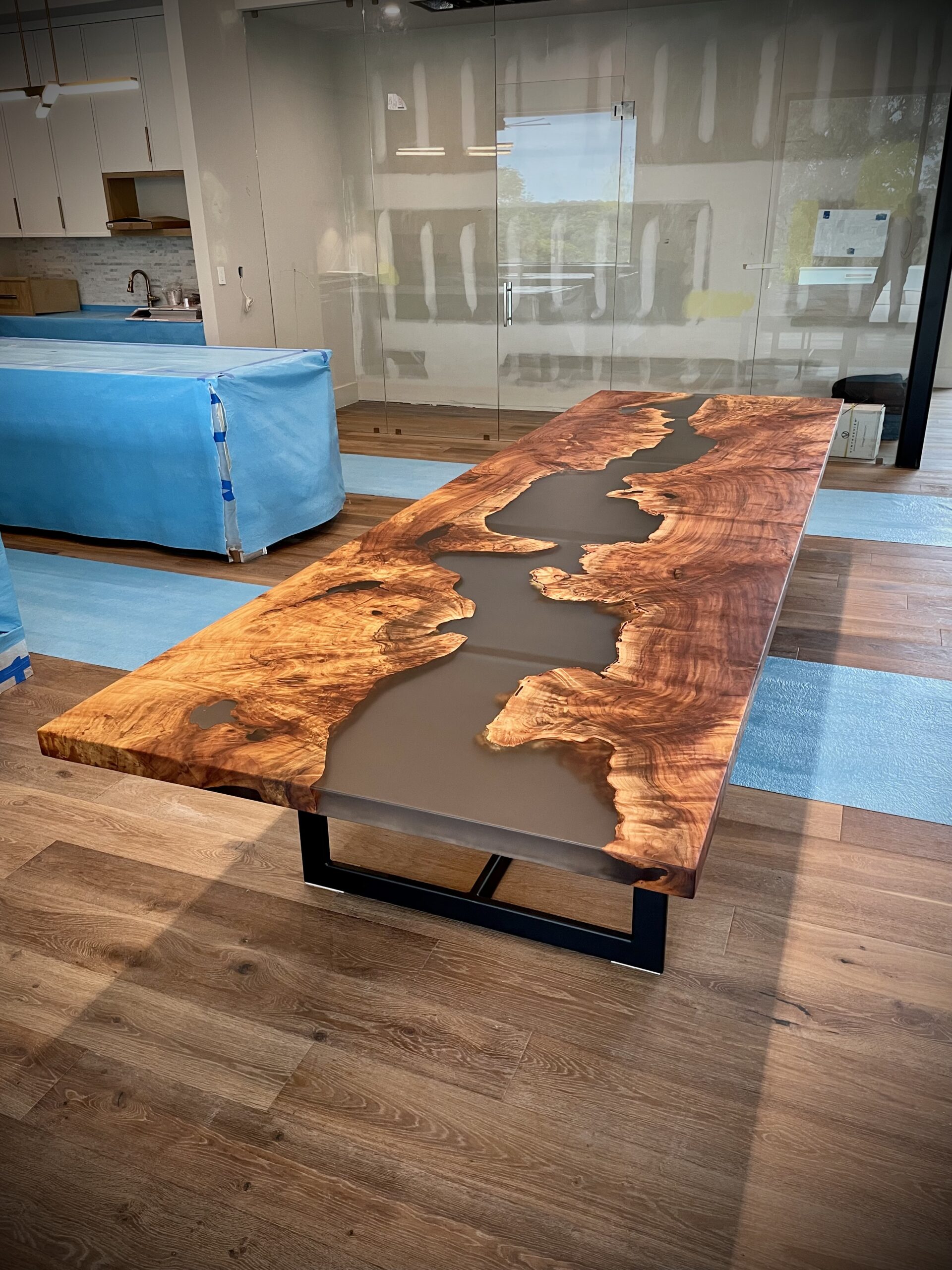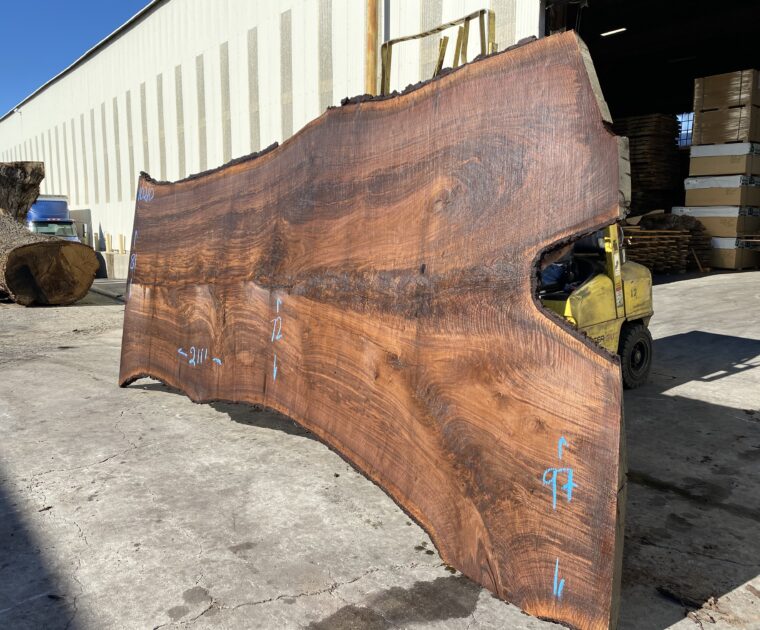Which Wood Slabs Make the Best Table?
The dining table has long been one of a family’s most cherished heirlooms. Where multiple generations gather to celebrate special occasions, hold some of their most important conversations, and share all their best stories.
It’s a special piece of furniture that can truly make any house a home.
Given the role your next dining table will play for your family, why buy a bland, mass-produced big box store table? Instead, consider a live edge dining table with a timeless design. Not only will you be investing in a one-of-a-kind, custom designed piece for your home, but with the wood slab you choose you’ll be memorializing the natural beauty of an amazing tree.
Even more special, every live edge slab delivers its own rich, beautiful, unique look. No two are the same. Not even consecutive pieces cut from the same log. And every slab has a story to tell — no matter what type of design motif you use it in, from the most modern and contemporary space to a more traditionally rustic interior.
In fact, the days of natural wooden furniture only belonging in a cabin in the woods are long gone. Along with the myth that perpetuated that notion.
5 Most Common Wood Species for Live Edge Tables
The extraordinary truth about live edge slabs is that each one is like a human fingerprint — they are 100% unique, no two exactly the same. What’s just as awesome is that the greatest beauty of slabs is revealed, paradoxically, in their imperfections and “flaws,” those irresistibly gorgeous characteristics that last for decades when properly cared for.
As you may realize, the decision to go with a live edge dining table may be quick and easy. But choosing which species can be quite challenging. There are softwoods and hardwoods. Exotics and domestics. Light, dark, and medium colors. And an array of figures and patterns.
So which live edge slab species do you pick?
Each has its own nuances, the type a custom furniture maker who specializes in live-edge furniture knows intimately. So we suggest you reach out to an experienced woodworker who can guide you through all the factors to consider, like size and shape of the slab.
But before taking all the design specs into account, the best place to start is choosing the species of your live edge slab. And there’s a wide array for you to choose from. To help get you started, we’ve gone ahead and listed the 5 most popular live edge slab species we seen people use:
Jump To The Different Sections
Walnut
A fantastic species belonging to the Juglandaceae family, Walnut trees comprise over 20 different varieties. Including the three types we carry at GL Veneer for live edge tables — Bastogne Walnut, Black Walnut, and Claro Walnut. Renowned for their durability and rich dark colors, Walnut slabs become ideal dining tables. Making them one of the most sought-after species for that purpose, and slightly more expensive than other species we recommend.
Claro Walnut
While it’s accurate to say GL Veneer specializes in Claro Walnut Slabs, it’s more fair to call our passion for these live edge slabs an obsession. And clearly there are worse things to be obsessed with — Claro Walnut is one of the most popular species we sell, as many of our customers are drawn to the wood’s colorful grain and gorgeous figure. Historically, the term “Claro” was originally used to describe old world Walnut grown in Spanish California. While a lot has changed since then, the beautiful wood of Claro Walnut has not. Today it’s prized for the same wildly colorful and variegated wood — a rainbow of color with dark brown and tan marbling in almost every piece.

Black Walnut
Hands down, Black Walnut Slabs are one of the most popular domestics – and true woodworker favorite – due to their beauty and workability. True to its name, the heartwood of Black Walnut is characterized by a beautiful blend of colors, from rich dark brown to subtle purple tones. A gorgeous wood that easily maintains the aesthetic of a classic space, Black Walnut is also capable of standing out elegantly in a bright, modern room with lots of white color and light. Sourced from the North American Midwest, the species has become a staple over the years.
Bastogne Walnut
A rare hybrid species coveted by many woodworkers, the California native Bastogne Walnut is a cross between Claro Walnut and English Walnut — the result of the two parent trees being grafted for increased nut production on orchards in the Golden State’s Central Valley. Considered to be the densest, strongest wood of all the Walnuts, Bastogne Walnut Slabs vary in color, but it’s typically a dark brown hue featuring an incredible marbling figure that makes for an excellent live edge slab choice.

Monkey Pod
In a recent push to preserve the world’s exotic hardwoods, many species are now facing increased forest management regulations. Fortunately, Monkey Pod doesn’t require such strict oversight, as this species flourishes naturally in great abundance – all around the world – and is sourced responsibly. Featuring dramatic colors and tremendous movement throughout its grain, Monkey Pod Slabs exude an undeniable magnetism that attracts woodworkers and designers alike. The wood is characterized by a streaming blend of vibrant gold, black, and yellow hues that create highly figured and wild grain patterns. To be clear, this type of Monkey Pod – from Hawaii – is the “Albizia Saman” variety of the species and shouldn’t be confused with its Central and South American cousin known as “Parotta” or “Guanacaste.”
Cottonwood Burl
In most places it grows, Cottonwood is usually thought of as a “throw away” wood. But not in California, where Fremont Cottonwood trees produce stunningly gorgeous live edge slabs. The beautiful golden brown honey color of the wood is almost always figured, and generally has a beautiful layer of burl on the outer edge of the slabs — a perfect choice for any project looking to make a statement. In fact, the live edge is almost medieval looking, with spiny sharp edges that add a dramatic look when encased in epoxy resin tables. Delivering a lustrous shine and naturally rich appearance, the grain of Cottonwood Burl Slabs opens up a myriad of creative opportunities to showcase your unique design approaches.

Mappa Burl
Originally from Western Europe and the only species of Poplar that develops this rare, distinctive figure and burl, Mappa Burl is one of those species you recognize immediately. A cousin of the Fremont Cottonwood, it has the same high-impact character grain, and is often used in high-end applications and live edge furniture. What makes the burl pattern of Mappa Burl Slabs even more special is that it looks more like an ingrown bark than the true burl seen in other trees. Of course, what also can’t be overlooked is the unmistakable color of Mappa Burl — a light creamy heartwood that’s spotted with darker clusters and a pale yellow to nearly white sapwood.
Oak
Legendary for its strength and durability, Oak is a timeless wood that has been revered throughout the ages. It also grows prolifically around the world — with more than 100 Oak species belonging to the family. But of all the varieties, GL Veneer primarily carries Red Oak Slabs and White Oak Slabs. Known for its clean, aesthetically pleasing grain, White Oak sometimes produces an exemplary flakey pattern among quarter-sawn live edge slabs. Also known as “Tiger Flake,” this type of figure is produced when the log is quarter cut, and the medullary ray is exposed. Color wise, the elegant wood of White Oak ranges from bone white to a golden-brown and tan. Interestingly, California White Oak in particular is sometimes classified as a weed because it grows so big, so fast, and so pervasively all across the Golden State. What we see, though, is huge potential — a beautiful piece of wood with gorgeous color and a uniquely organic live edge.
Our Favorite Underrated Species for Live Edge Tables
The purpose of a tabletop is pretty simple and obvious. But merely meeting that functional requirement isn’t always good enough. We also want our furniture to be attractive, artful, and exciting. And sometimes, the perfect live edge slab for the job is often the most underrated. Which is why we’re listing a few species that aren’t as widely used as those mentioned above in our “5 Most Common” list. To add lasting beauty to your next project, consider these three underrated live edge slab species:
Sequoia
Redwood trees are among the largest species on earth. Specifically Sequoia Giganteum, or more familiarly, the “Sequoia.” An ancient, old-growth Redwood known for extremely tight and straight grain patterns, these national treasures can actually yield a dramatic variety of grains and figures. While the salmon reddish color is a signature of the Giant Sequoia, our Coastal Redwood slabs feature the lace burl or flamed figure this variety is renowned for. But what all these amazing Sequoia live edge slabs offer is the unique ability to elevate your project to heights that only wood this storied and rare can. In fact, given how extremely difficult it is to source Sequoia – legally and sustainably – we’ve been fortunate enough over the last 40 years to come across a few of these old-growth Redwoods that the authorities needed to be properly salvaged after they fell in parks and forests and created natural hazards. Even more fortunate, we were able to add the recovered Sequoia material to the GL Reserve Collection, the most elite wood in our vast inventory.

Buckeye Burl
The dramatic feel and exotic look of Buckeye Burl live edge slabs is driven by their unique shapes, rich grain, and swirls of color. Growing specifically in Central California, Buckeye Burl is actually hard to spot because a large portion of the tree – and most of the wood it produces – grows underground. But once it’s dug up and sliced into slabs, the mysterious mystique of Buckeye Burl is fully realized in a series of amazing patterns and captivating color. Though, you’ll find that the signature to this unique species’ appeal are the voids and irregular shapes formed in the wood. While it’s true these unique slab shapes can limit their applications, they do make a spectacular choice for epoxy table designs — a perfect pairing to showcase the natural beauty of the wood in any desirable shape.
Sycamore
There’s no greater example of the adage that “what is most valuable is often underrated” than Sycamore. Known for its longevity and hardiness, it’s one of the largest species in our forests today, and one of the most valuable — to both animals and humans. While Sycamore isn’t always the top choice for woodworkers, its fine grain, beautiful coloring, and the lace figure it presents when quarter sawn combine to rank it among the most appealing species for live edge furniture. And luckily, there’s plenty of it — like most California trees, Sycamore trees grow big, fast, and everywhere in the Golden State.












